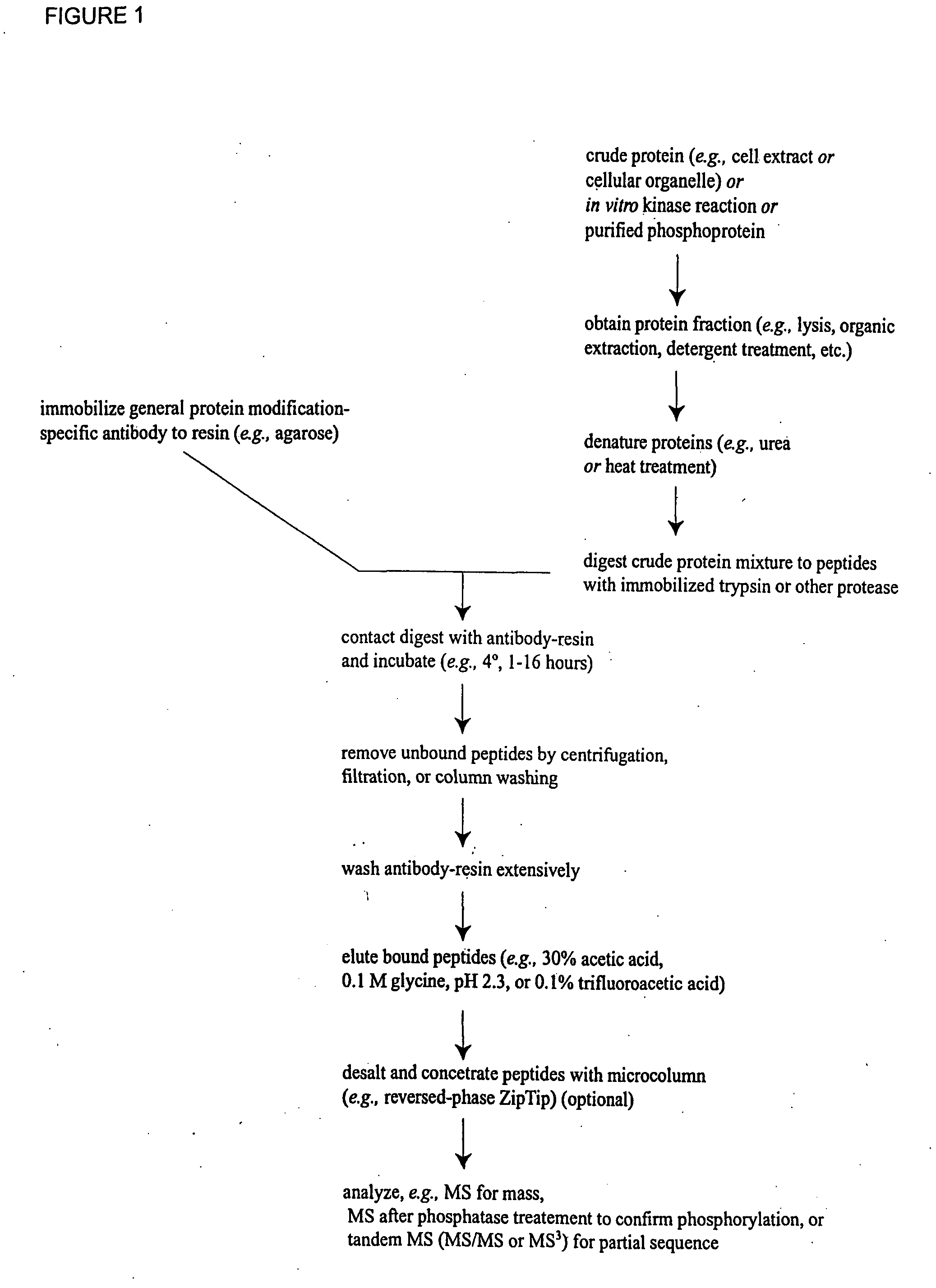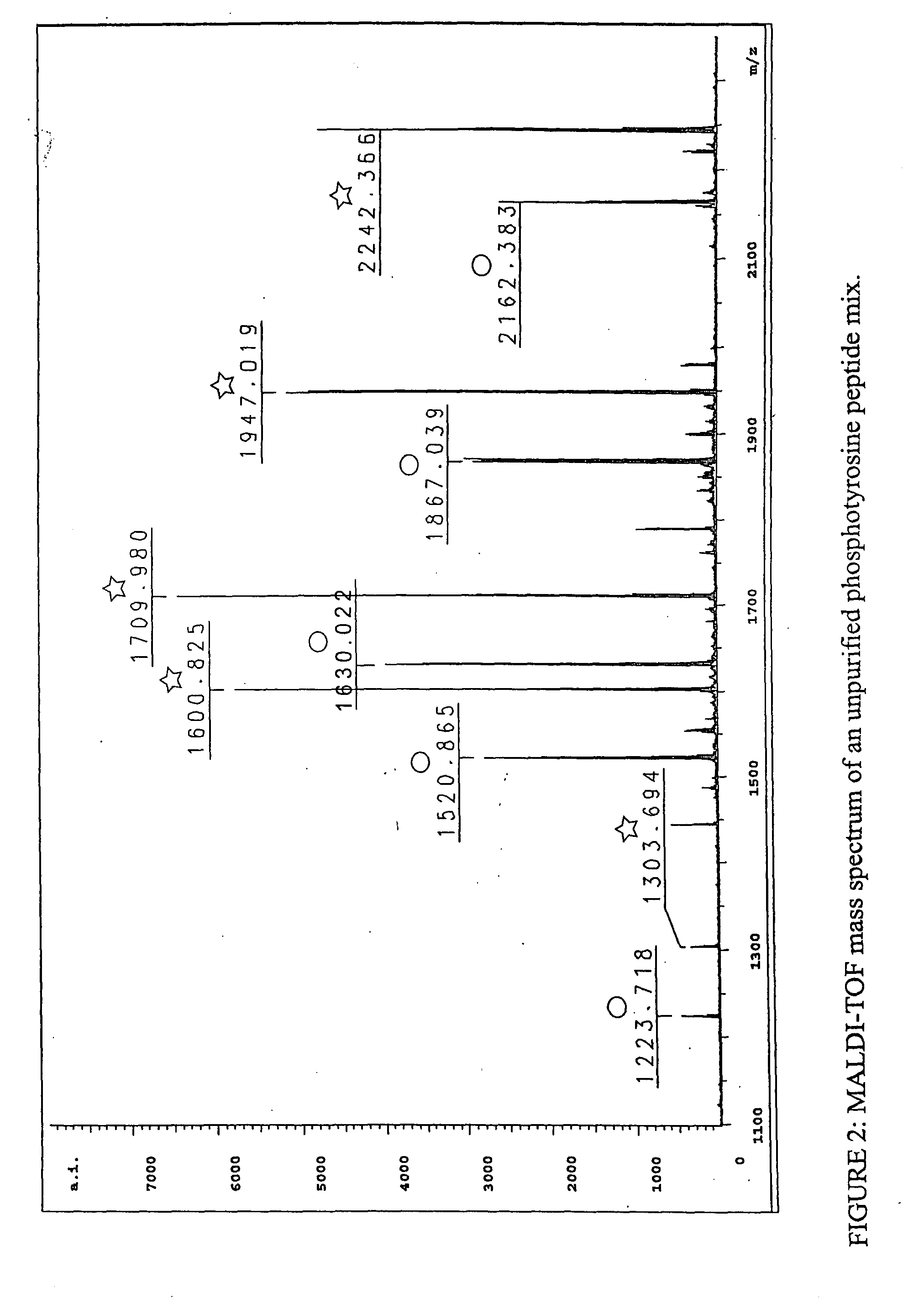Immunoaffinity isolation of modified peptides from complex mixtures
- Summary
- Abstract
- Description
- Claims
- Application Information
AI Technical Summary
Benefits of technology
Problems solved by technology
Method used
Image
Examples
example i
A. Isolation of Phosphotyrosine-Containing Peptides from a Peptide Mixture
[0162]To establish that phosphopeptides can specifically be purified from complex mixtures without contamination from nonphosphorylated peptides, the method of the invention was used to isolate phosphotyrosine (p-Tyr)-containing peptides from a mixture of phosphorylated and nonphosphorylated synthetic peptides. A phosphotyrosine peptide mix comprising 5 phosphotyrosine-containing peptides and their 5 nonphosphorylated partner peptides was prepared (Table 1); note the nonphosphorylated peptides have the same sequences as the phosphorylated peptides but are not phosphorylated, that is, they contain tyrosine instead of phosphotyrosine. Peptides were synthesized by Fmoc chemistry on a Rainin / Protein Technologies Symphony peptide synthesis instrument and using Fmoc-Tyr(PO(OBzl)OH)—OH as the phosphotyrosine monomer. See Perich, Lett. Pept. Sci. 6: 91 (1999). The peptide mixture covers a broad mass range designed to ...
example ii
A. Isolation of Phosphotyrosine-Containing and Phospho-Akt Substrate Peptide Subsets from a Digested Crude Cell Extract
[0179]Example I demonstrates that several phosphorylation-specific antibodies can be employed in the method of the invention to selectively separate desired phosphopeptides from non-phosphopeptides. The antibodies may be general modification-specific antibodies or motif-specific, context-independent antibodies that recognize a short non-unique motif comprising several invariant residues, which motif is present on a plurality of different peptides or proteins within a genome. As shown in Example I, the antibodies can distinguish phosphopeptides from non-phosphopeptides even when the only difference between the peptides is the presence or absence of a phosphate group. In the present Example, it is shown that desired phosphopeptides may be selectively isolated by the method of the invention from a complex mixture containing phosphopeptides of different types. The metho...
example iii
Isolation of Phosphotyrosine-Containing Peptides from an Extract of Cells
Overexpressing Epidermal Growth Factor Receptor
[0190]The selective isolation of modified peptides from a complex mixture according to the method of the invention was further demonstrated using a digested whole cell extract and a general phosphotyrosine antibody to isolate known phosphopeptides. A model system, the A431 epidermoid carcinoma cell line overexpressing the human epidermal growth factor receptor (EGFR), was selected since the modification (phosphorylation) of sites on this protein is well-studied. Activation of EGFR family members is associated with many tumors. Five sites of in vivo autophosphorylation have been identified in EGFR: three major sites (Tyr-1068, Tyr-1148, and Tyr-1173) and two minor sites (Tyr-992 and Tyr-1086) (Downward et al., J. Biol. Chem. 260: 14538-546 (1985); Hsuan et al., Biochem. J. 259: 519-27 (1989); Margolis et al., EMBO J. 9: 4375-380 (1990); Walton et al., J. Biol. Chem....
PUM
| Property | Measurement | Unit |
|---|---|---|
| Length | aaaaa | aaaaa |
Abstract
Description
Claims
Application Information
 Login to View More
Login to View More - R&D
- Intellectual Property
- Life Sciences
- Materials
- Tech Scout
- Unparalleled Data Quality
- Higher Quality Content
- 60% Fewer Hallucinations
Browse by: Latest US Patents, China's latest patents, Technical Efficacy Thesaurus, Application Domain, Technology Topic, Popular Technical Reports.
© 2025 PatSnap. All rights reserved.Legal|Privacy policy|Modern Slavery Act Transparency Statement|Sitemap|About US| Contact US: help@patsnap.com



